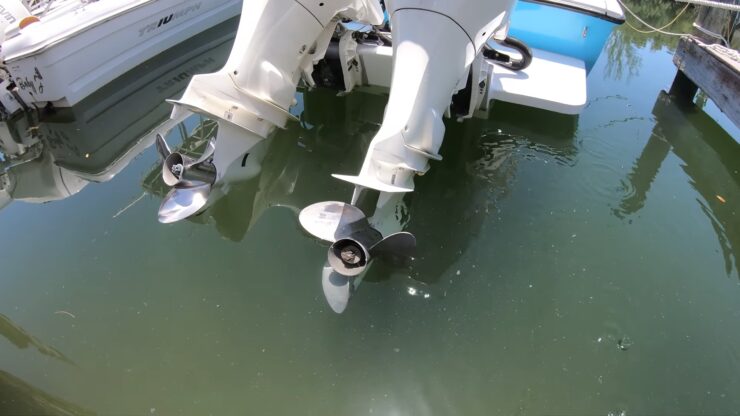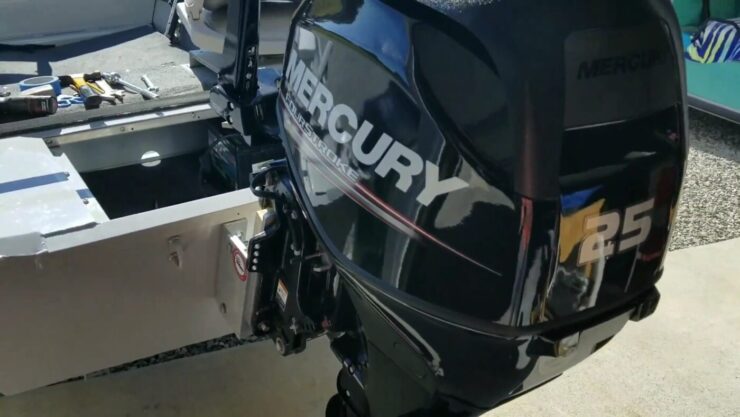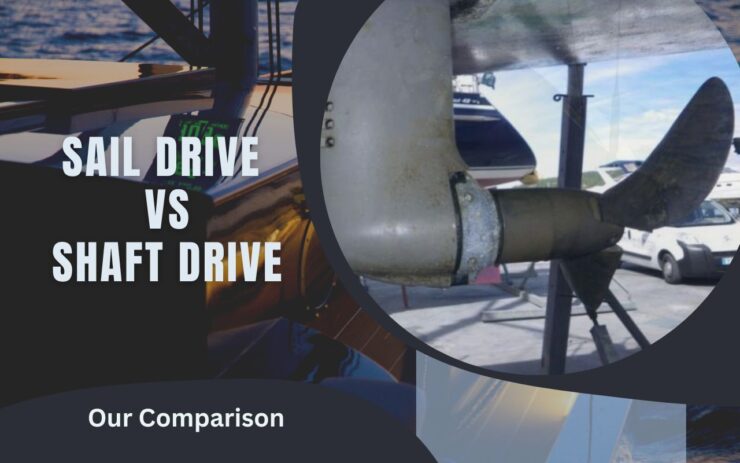You’re trying to choose between shaft drive and sail drive as your engine. We know how difficult a decision this can be. So we’re here to help! So, who’s the winner between sail drive vs. shaft drive?
Now you must’ve been intrigued by this short preview. So let’s jump into the segment to know more.
Table of Contents
ToggleSail Drive vs. Shaft Drive: Quick Comparison
To start off we have a short comparison of their important features. Because knowing about your boat’s engine can take you a long way. Here you go, have a quick look:
| Comparison Factor | Sail Drive | Shaft Drive |
| Boat Size | Smaller | Bigger |
| Engine Alignment | Easy | Needs Precision |
| Sound and Vibration | Quiet | Loud |
| Performance | High Performance | A bit low performing |
| Maintenance | Costly | Low-Cost |
| Price | Higher | Lower |
Well that was a glimpse about what these engines are like. So moving on to the thorough discussion on this!
Sail Drive vs. Shaft Drive: Detailed Comparison
Now both the sail drive and the shaft drive serve similar purposes. However, there are some significant differences. But these differences are not as intricate as the differences between cmap and Navionics. So here we’ll walk you through them in detail.
Boat Size
Whether you have a smaller or a bigger boat can affect how you choose the engine. So let’s see which one best fits your preferences.
Sail Drive
Sail drives are more often used for relatively smaller boats. To be specific, sail drives are made for engines below 75 horsepower. Due to this engine power barrier, sail drives are used for boats less than 50 feet.
Shaft Drive
Shaft drives have been conventionally used for an extended period. So, they are made for all shapes, sizes, and engine capacities of boats. So if you have a smaller boat go for the sail drive. Now, for bigger boat yachts go for the shaft drive. Otherwise, due to a mismatch of sizes, there can be a scan problem with the structure.
Engine Alignment

The engine alignment in a boat is quite critical. Otherwise, the boat might not sail to begin with. So let’s check out which one’s easier to align and which one’s difficult.
Sail Drive
The engine alignment in sail drives is not very critical. The propeller is horizontally mounted, which is smaller in size. Also, you don’t need to maintain any stuffing box. So, all these things give the sail drive an advantage over others.
Shaft Drive
The engine alignment in shaft drives requires more precision. In most cases, they need realignment several times. But it’s relatively mechanically simple to do.
Sound and Vibration
Now the purpose you’re using the boat for will also determine the decision here. Suppose you’re out fishing, you don’t want a loud engine to drive the fish away. So, let’s now have a look at the differences.
Sail Drive
Sail drives are very quiet. Due to using modern technology and compact size, it can provide such a facility. Also, sail drives don’t vibrate that much. However, misalignment in the flywheel drive splines may cause vibrations. So, keep them in check and you’ll be all good.
Shaft Drive
Shaft drives produce more vibration and sound. They are always louder than sail drives. As the rpm increases, the sound and vibration are felt more rigidly.
Performance

Now, this is the most important feature you’re going to look for in an engine. So let’s check out which one’s the better one.
Sail Drive
Sail drives comparatively perform better. They produce around 40 horsepower. Also, they have less drag coefficient due to their compact size. Thus it helps them to reach a reasonable speed. Sail drives can reach the torque band comparatively faster.
Shaft Drive
Shaft drives have their props aligned at an angle. This causes the shaft to produce less effective horsepower. For this reason, performance is affected. For example, in a typical 40 feet boat, a shaft drive is usually 3-4 horsepower behind the sail drives.
Maintenance
Well no matter what type of engine you buy, maintenance is the key. Otherwise, without proper maintenance, your Yamaha might run into problems a lot.
Sail Drive
Sail drives need more maintenance. This can add up to the cost or even you might have to replace it. Hence might cost you a lot in the future.
Shaft Drive
Shaft drives are usually easy to maintain, even in challenging situations. Shaft drives have been traditionally used for a long time. So, they are more tested to prevent unwanted situations.
Price
The price point can be an important deciding factor. So let’s check out the range these products are available on.
Sail Drives
Sail drives cost around $3,500-5,000. Now, this is a little out there in price, but the quality justifies it.
Shaft Drive
Shaft drives are relatively cheaper. It costs around $500$-1,000 to buy a shaft drive. Low maintenance and rough usability make them lucrative at this price.
FAQs
What does a sail drive do?
A sail drive is a transmission system for a boat. This system’s inboard engine has a horizontal output shaft.
How does a shaft drive work?
The driveshaft is a spinning tube that transmits power. That is, from the engine to the vehicle’s back at the differential. It does this by transferring the spinning power from front to back.
What causes a drive shaft to fall off?
Sometimes, the bolts holding the u-joints in place cause this. These joints can become loose or fall off either of the driveshaft or to the transmission or differential.
Do sail drives have prop walks?
Sail drives do have prop walk, although the degree and direction of the prop walk can vary depending on the specific sail drive system and the vessel’s configuration. Prop walk is the tendency of a boat’s propeller to “walk” the stern in one direction or another when the boat is in reverse.
This is caused by the interaction of the propeller with the water and is influenced by factors such as the direction of rotation of the propeller, the pitch and diameter of the propeller, and the design of the sail drive system itself.
In general, sail drives with smaller propellers and lower pitch tend to have less prop walk than those with larger propellers and higher pitch. The direction of the prop walk can also be influenced by factors such as the direction of the sail drive’s offset (if any) and the shape of the vessel’s hull. It’s important for sailors to be aware of the prop walk characteristics of their sail drive system and vessel, as this can affect maneuvering in close quarters and docking.
Practicing reversing and turning maneuvers can help sailors become familiar with their vessel’s prop walk characteristics and learn how to use them to their advantage.
What is the most efficient sail design?
The most efficient sail design depends on the specific application, as different sail designs are optimized for different wind speeds, angles, and boat types. However, some of the most commonly used and efficient sail designs include:
- Triangular sails: Triangular sails, such as the jib and mainsail, are the most common type of sails used on sailboats. They are efficient in a wide range of wind conditions, from light airs to strong winds. Triangular sails work by creating lift as wind flows over their surfaces, and they can be trimmed and adjusted to optimize the balance between lift and drag.
- Wing sails: Wing sails are used on high-performance sailboats such as catamarans and trimarans. They have a similar shape to an airplane wing, with a cambered profile and a rigid frame. Wing sails are highly efficient and can generate more lift than a traditional sail of the same area, but they are also more complex to design, build, and operate.
- Square sails: Square sails are large, four-cornered sails used on traditional sailing ships such as tall ships. They are efficient in downwind conditions, where they can catch a lot of wind and propel the ship forward at high speeds. Square sails are less efficient than triangular sails in other wind angles, and they require a large crew to handle and adjust.
- Asymmetric spinnakers: Asymmetric spinnakers are specialized sails designed for sailing downwind. They have a curved shape and a large surface area, and they are often used on racing sailboats. Asymmetric spinnakers are highly efficient in light to moderate winds, but they require careful trimming and handling to maintain their shape and optimize their performance. It’s important to note that sail efficiency is also affected by factors such as sail material, sail shape, and the sailor’s skill and experience in sail trimming and handling. The most efficient sail design for a given application may also depend on the sailor’s preferences and priorities, such as ease of handling, speed, or comfort.
Conclusion
We tried to cover up all the things that can arise between sail drive vs. shaft drive. Hope we were able to help to make the right decision. your confusion.
I’m Liam Jackson, the proud owner and driving force behind KayakPaddling.net. Born somewhere in the expansive beauty of the United States, I’ve nurtured a lifelong passion for kayaking and fishing that has led me to explore the far corners of our nation’s waterways.
Related Posts:
- 15 Best Baitcasting Reel Under $100 2024 - Improve…
- 16 Best Kayak For Beginners 2024 - Kayaking Adventure Gear
- 17 Best Trolling Reels 2024 - Enjoy your Fishing Adventure
- 12 Best Beach Wagons & Carts 2024 - For All-Terrain
- 10 Best Fishing Kayak Under $1000 2024 -…
- 20 Best Inshore Spinning Reels 2024 - Capturing All…












